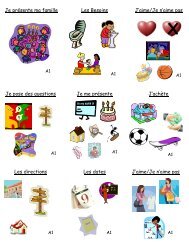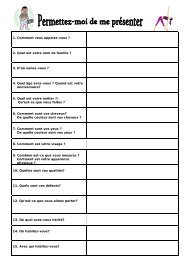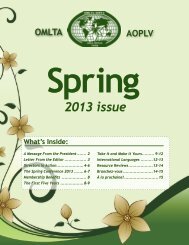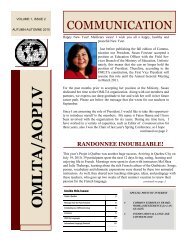2012 Issue - Ontario Modern Language Teachers
2012 Issue - Ontario Modern Language Teachers
2012 Issue - Ontario Modern Language Teachers
You also want an ePaper? Increase the reach of your titles
YUMPU automatically turns print PDFs into web optimized ePapers that Google loves.
The First<br />
Five Years<br />
e<br />
Classroom Management<br />
Strategies<br />
The classroom can be a busy place with<br />
students who are uninterested in learning.<br />
This lack of interest leads to negative<br />
attitude and unwelcome behaviour.<br />
The key to their success is for them<br />
to both enjoy the subject and want to<br />
learn. As a teacher, I must then compete<br />
against entertaining and powerful<br />
mediums such as television and computer<br />
games. I need to make it fun. The<br />
following ideas are things I have used to<br />
keep the students’ interest.<br />
I am a Core, Pre-Intensive, Intensive and<br />
Post-Intensive French Teacher in a small<br />
school called St Joseph, the small school<br />
with a big heart, in Toledo, <strong>Ontario</strong>. I<br />
teach all the classes in the school from<br />
Kindergarten to Grade 7. I use one<br />
strategy with my grade 1 and 2/3 and a<br />
different one with my grade 3/4, 4/5, 6<br />
and 7.<br />
The first strategy is using songs, finger<br />
songs, and those with gestures. I teach<br />
them the Quebec sign language at the<br />
same time. Children at this level often<br />
love to sing. Singing has several positive<br />
effects on the children. First, it<br />
releases the energy they have inside<br />
them, thus it may reduce their desire to<br />
talk later in class. The nature of singing<br />
in French also helps them learn a second<br />
language. The other component in my<br />
teaching through songs is using sign<br />
language at the same time. The sign<br />
language is a tool for them to learn the<br />
language. The students learn the Quebec<br />
sign language used in Quebec and<br />
they find it fun to use the signs as well.<br />
The students use the visual of a sign and<br />
it helps them to remember the French<br />
word. These methods work as they ascribe<br />
to the multiple intelligence model.<br />
To finish the class if time permits, we<br />
play games, such as 7up and 10. In both<br />
of these games, students communicate<br />
with each other in a fun way or practice<br />
their numbers.<br />
The second strategy I use is using checkmarks<br />
or points. I have a list of students<br />
for each classroom (3/4, 4/5, 6 and<br />
7). I give points to my students if they<br />
speak to me in French before the class,<br />
in the class, hallways or in the yard.<br />
For example, when I have morning bus<br />
duty, I greet each student in French as<br />
they get off the bus and they respond<br />
back to me in French. After they get five<br />
checkmarks, they get a sticker and after<br />
five stickers they get a prize. I am impressed<br />
how often students without help<br />
would say something to me throughout<br />
the day in French. Some days weaker<br />
students will come up to me, point<br />
to something, and ask how to say it<br />
in French. I would then tell them the<br />
translation and the students would say a<br />
sentence of some kind to me about it. I<br />
would then tell them in French they get<br />
one point. Throughout this teachable<br />
moment their faces are lit up with enthusiasm.<br />
Students can see that French<br />
is not just spoken in the classroom.<br />
Lastly, at the end of the week I have<br />
raffles for the classes depending on the<br />
students’ behaviour such as showing<br />
respect to one another, working well,<br />
and participation in class. In this raffle<br />
all students’ names are in a box and<br />
one name is drawn for a prize. These<br />
prizes are usually larger than those I<br />
give out for the point system. Some<br />
unique prizes include things I find from<br />
my travels, such as France (my country<br />
of origin). The students are told that<br />
respect is given both ways. They learn<br />
that if they give I will give.<br />
At school all levels of students now<br />
come to me speaking French throughout<br />
the day using signs to remember words<br />
or asking me in French how to say it. In<br />
the classroom students are encouraged<br />
to listen to each other with respect and<br />
finish each week with a strong work<br />
ethic. Competing against the attention<br />
grabbing power of TV and computers<br />
will always be there, that is our reality.<br />
But through a reward strategy I have<br />
found that I have created a positive<br />
teaching environment at school in which<br />
students want to learn, participate and<br />
even have some fun.<br />
By Claudine Fenard<br />
Take It And Make<br />
It Yours<br />
e<br />
How the CEFR Has<br />
Impacted my Classroom<br />
More and more French teachers are<br />
beginning to bring the principles of the<br />
CEFR into their classrooms. Here are<br />
the experiences of two Core French<br />
teachers from Durham DSB’s “CEFR in<br />
Action” group of pioneering educators<br />
who have now made the CEFR a regular<br />
part of their daily teaching.<br />
“I used to faithfully utilize the teacher’s<br />
resource guide in order to plan and<br />
orchestrate my Core French lessons.<br />
Now, since I have learned about the<br />
principles of CEFR, I have made a shift<br />
in my teaching practices and philosophy.<br />
When I now plan my lessons, I ask<br />
myself:<br />
• How am I going to maximize the<br />
amount of time students are speaking<br />
in French?<br />
• How can I implement lessons that are<br />
authentic and/or action-oriented?<br />
• How am I able to motivate my<br />
students to learn?<br />
Since I have implemented the principles<br />
of CEFR, I have seen an increase in student<br />
talk, motivation and enthusiasm.<br />
In fact, one of my grade 6 students who<br />
has consistently demonstrated a lack<br />
of enthusiasm for learning, not only in<br />
French, jumped out of his seat as we<br />
began examining fast-food menus on the<br />
Internet in French. He was so eager to<br />
share his food selections and converse<br />
with his peers in French! This was a<br />
huge breakthrough for that student, not<br />
to mention for me as an experienced<br />
teacher!<br />
The Internet has in large part been one<br />
of my most valuable resources. Some<br />
sample activities have included texting<br />
with a friend, bringing in and describing<br />
family photos, creating a new attraction<br />
for the Carnaval de Québec and ordering<br />
a meal in a restaurant. As a result of<br />
7













